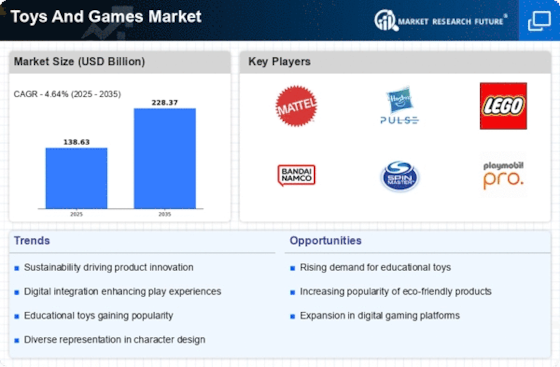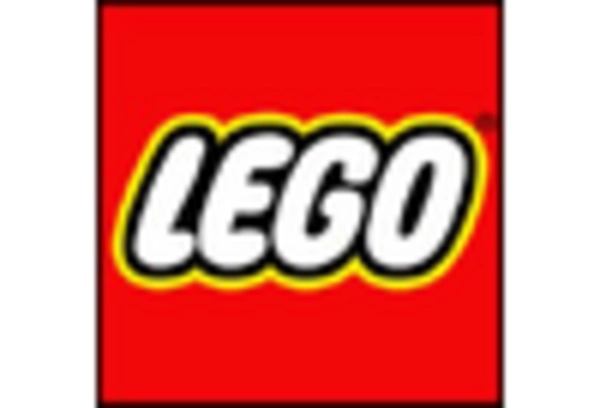The Toys and Games Market is currently characterized by a dynamic competitive landscape, driven by innovation, digital transformation, and strategic partnerships. Major players such as Mattel (US), Hasbro (US), and LEGO (DK) are at the forefront, each adopting distinct strategies to enhance their market positioning. Mattel (US) has focused on expanding its digital offerings, integrating augmented reality into its product lines, which appears to resonate well with tech-savvy consumers. Meanwhile, Hasbro (US) has pursued a strategy of diversifying its portfolio through acquisitions, notably enhancing its presence in the educational toys segment. LEGO (DK), on the other hand, emphasizes sustainability, committing to using sustainable materials in its products by 2030, which aligns with growing consumer demand for environmentally friendly options. Collectively, these strategies not only shape their individual trajectories but also influence the overall competitive environment, fostering a climate of innovation and responsiveness to consumer preferences.
In terms of business tactics, companies are increasingly localizing manufacturing to mitigate supply chain disruptions and optimize logistics. This trend is particularly evident in the moderately fragmented structure of the market, where key players leverage their scale to enhance operational efficiencies. The collective influence of these companies is significant, as they navigate challenges and opportunities in a landscape that demands agility and responsiveness.
In August 2025, LEGO (DK) announced a partnership with a leading tech firm to develop a new line of interactive building sets that incorporate artificial intelligence. This strategic move is likely to position LEGO at the cutting edge of the market, appealing to a younger demographic that values interactive play experiences. The integration of AI into traditional play patterns could redefine consumer engagement and set new standards for innovation in the industry.
In September 2025, Hasbro (US) launched a new initiative aimed at enhancing its sustainability practices, pledging to reduce plastic use in packaging by 50% over the next five years. This commitment not only addresses consumer concerns regarding environmental impact but also aligns with broader industry trends towards sustainability. By taking proactive steps in this direction, Hasbro may strengthen its brand loyalty and appeal to environmentally conscious consumers.
In October 2025, Mattel (US) unveiled a new digital platform that allows consumers to customize their toy purchases, thereby enhancing the consumer experience. This initiative reflects a growing trend towards personalization in the market, suggesting that Mattel is keen to leverage technology to differentiate itself from competitors. Such a move could potentially reshape consumer expectations and drive engagement in a highly competitive landscape.
As of October 2025, the Toys and Games Market is witnessing a pronounced shift towards digitalization, sustainability, and the integration of advanced technologies such as AI. Strategic alliances are increasingly shaping the competitive landscape, enabling companies to pool resources and expertise to innovate more effectively. Looking ahead, competitive differentiation is likely to evolve, with a marked transition from price-based competition to a focus on innovation, technological advancement, and supply chain reliability. This evolution suggests that companies that prioritize these areas will be better positioned to thrive in an increasingly complex market.

















Leave a Comment